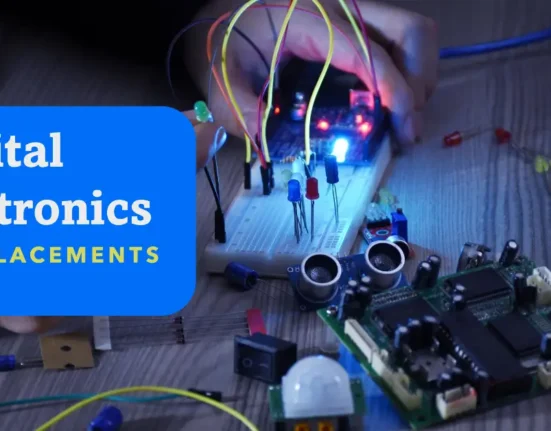“The best way to predict the future is to create it.” – Peter Drucker
The semiconductor manufacturing industry has been a cornerstone of modern technology. And unlike other industries, it is trying to evolve at a greater pace with an expected 9.6% CAGR increase in spending on digital technologies over the next decade.
The main reason that is fueling these rapid upgrades is the increased demand for advanced electronics. Due to this increased demand for advanced electronics, semiconductor manufacturers are facing the challenge of optimising their existing complex production processes.
In the process of optimising semiconductor manufacturing, digital twins are coming up with a promising solution. Digital twin is not a new concept in the industry , but for the semiconductor manufacturing industry , yes, it is.
In this article, we will try to understand what are digital twins in semicondcutor manufacturing which is poised to transform semiconductor manufacturing by creating dynamic, virtual replicas of physical systems. And in next article we will try to understand “How Digital Twins are Transforming Semiconductor Manufacturing?”
Trending: Is Nvidia considering to buy Intel ?
Table of Contents
ToggleWhat are Digital Twins ?
A digital twin is a virtual model designed to accurately reflect a physical object, process, or system. This model is continuously updated with real-time data, allowing it to simulate the behaviour and performance of its physical counterpart under various conditions.
Digital twins are already in use in various industries, such as aerospace and automotive, where they are used to enhance design, operation, and maintenance processes by providing a detailed and dynamic representation of complex systems.
You can understand it like creating the schematic and checking the operation of your electronics or electrical circuit in Matlab and then simulating it by applying real life constraints.
What are Digital Twins in Semiconductor manufacturing industry ?
As discussed above, digital twins are basically replicas of the physical devices or systems in virtual mode with an effort to bridge the gaps between product design and production and then back from production to product.
The same properties apply to the semiconductor manufacturing industry. Digital twins in the semiconductor manufacturing industry can be defined as creating replicas of physical semiconductor fabs to optimise the manufacturing process and bridge the gap between design and production.
Semiconductor manufacturers have too much data, which is going unleveraged and unnoticed, and the digital twin in semiconductor manufacturing is an effort to leverage that data to improve decision-making, from demand planning to sustainability initiatives.
Also Read : US-India Chip Cooperation Gains Momentum
How Digital Twins are Created for Semiconductor Fabs ?
In semiconductor fabrication facilities (fabs), the creation of digital twins involves several crucial steps:
Data Collection: Extensive data is gathered from the physical fab, including information on machinery, production processes, and environmental conditions. Advanced sensors and IoT devices ensure accurate and continuous data collection.
Modeling: Using this data, a detailed digital model of the fab is created, encompassing all physical components and interactions. Sophisticated software tools and simulation technologies are employed to build this comprehensive model.
Integration: The digital model is integrated with real-time data streams from the fab, enabling it to mirror the current state of the physical environment dynamically. AI and data analytics play a critical role in processing and interpreting this data.
Simulation and Analysis: Manufacturers can run simulations on the digital twin to test various scenarios and predict outcomes. These simulations help identify bottlenecks, optimize workflows, and enhance overall efficiency.
Feedback and Improvement: Insights from the digital twin are fed back into the physical fab, fostering continuous improvement and alignment with optimal performance standards. This iterative process reduces downtime and increases yield.

Benefits of Using Digital Twins in Semiconductor Manufacturing
The adoption of digital twins in semiconductor manufacturing offers several significant benefits:
- Efficiency and Cost Savings: Simulating different production scenarios helps identify the most efficient processes, reducing waste and lowering production costs.
- Improved Quality Control: Real-time monitoring and analysis ensure that deviations from quality standards are promptly corrected, enhancing product yield and reducing the need for costly rework.
- Predictive Maintenance: Digital twins can predict equipment failures before they occur, allowing for timely maintenance and minimizing downtime.
- Enhanced Research and Development: Virtual testing environments accelerate the R&D cycle, fostering innovation and speeding up the time-to-market for new products.
However, implementing digital twins also presents challenges:
- Data Security: Protecting sensitive manufacturing data within the digital twin is crucial.
- Integration Complexity: Integrating the digital twin with existing systems and infrastructure can be complex.
Join our WhatsApp group
Conclusion
Digital twins represent a paradigm shift in semiconductor manufacturing, offering powerful tools to optimize processes, improve quality, and drive innovation. As the industry continues to evolve, the integration of digital twins will become increasingly critical in meeting the demands of modern technology.
Stay tuned for part two, where we will explore real-world applications and case studies of digital twins in semiconductor manufacturing, showcasing their transformative impact on the industry.
Discover more from WireUnwired
Subscribe to get the latest posts sent to your email.



